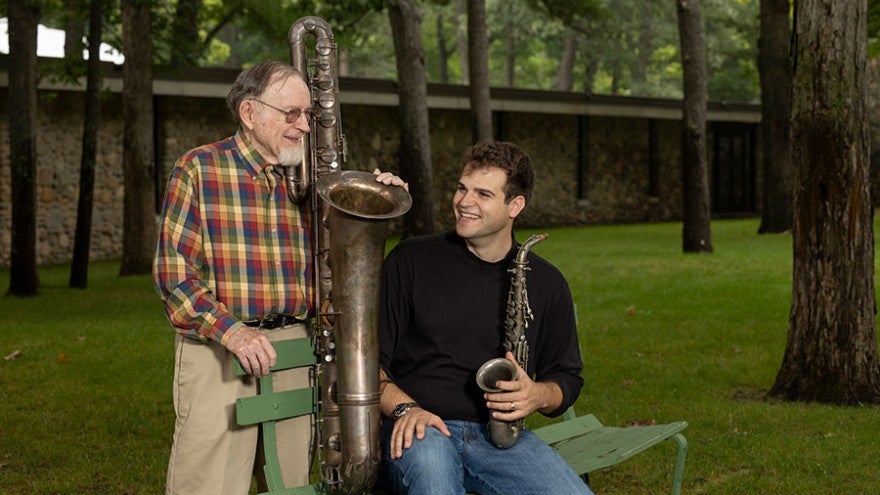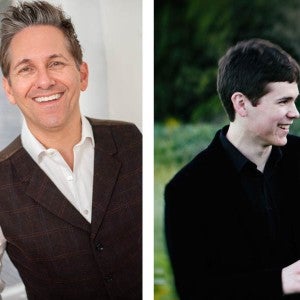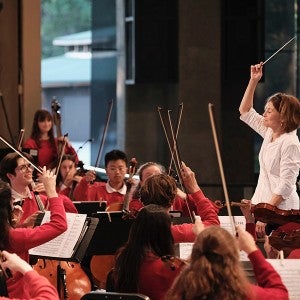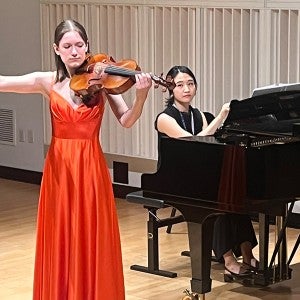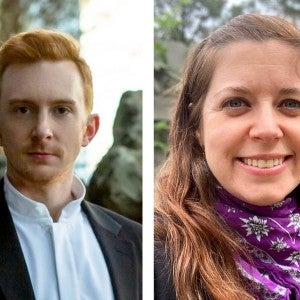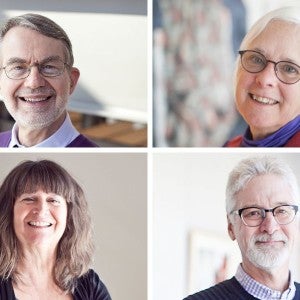Breathing new wind into an Interlochen treasure
Interlochen Arts Camp alumnus Jake Goldwasser shares his passion for vintage saxophones as the institution’s inaugural Greenleaf Curating Fellow.
On a July afternoon, the Interlochen Arts Camp saxophone studio explored one of Interlochen’s most unique treasures: the Leland B. Greenleaf Musical Instrument Collection. As the initial chorus of “what is this?” subsided, the collection’s curator, Jake Goldwasser (IAC 12), pulled an instrument from its shelf for the students to examine.
“I like to have students pass one of these saxophones around so they can feel how it sits in your hands, feel where the weight is,” Goldwasser says. “It’s one of my personal goals to get a vintage American saxophone into the hands of every young, upcoming artist.”
The Greenleaf Collection is an ideal place for saxophonists to enjoy hands-on encounters with historic instruments: The collection includes 33 saxophones, including two instruments from Adolphe Sax’s workshop, several early Conn instruments, and a rare straight alto saxophone. The nearly 300-piece collection was originally assembled by former C.G. Conn owner Carl D. Greenleaf and his son, Leland, as a physical history of Conn’s musical innovations. The collection was displayed at the C.G. Conn headquarters in Elkhart, Indiana until December 1969, when the Greenleaf family donated it to Interlochen Center for the Arts.
Learn more about the Greenleaf Collection’s history and contents
Today, the Greenleaf Collection is part of Interlochen’s archives: a vast trove of photos, audio recordings, and memorabilia dispersed in basements, closets, and storage rooms across campus. As Interlochen approaches its centennial in 2028, Director of Libraries Elizabeth Nelson (IAC/NMC 75, UNIV 82) and her team are working to unite, curate, and share the archives’ remarkable resources.
As a part of those efforts, Goldwasser has returned to Interlochen as the inaugural Greenleaf Curating Fellow. Over the course of his six-week fellowship, Goldwasser is cataloging, organizing, and updating the Greenleaf Collection with the goal of restoring the collection to its rightful place as one of the nation’s finest holdings of musical instruments.
“Interlochen is, for the first time in a long time, breathing new wind into a collection of instruments that is one-of-a-kind in this country,” Goldwasser says. “We’re trying to rebuild the collection and improve it so it’s more in line with the Greenleaf mission, which is to be an academic tool for students.”
“I’ve met some incredible people: wonderful students, faculty, and administrators. Everyone's really excited about this project.”
Rediscovering a historic saxophone
Goldwasser’s passion for vintage saxophones began when he discovered a new-in-box 1945 Buescher tenor saxophone—a moment he likens to the scene in Harry Potter and the Sorcerer's Stone when Harry picks up his wand for the first time.
“It still had the original pads, the original springs, the original paperwork….It was perfect,” he says.
Goldwasser spent the remainder of his master’s studies at Belmont University researching the history and pedagogy of vintage saxophones. In December 2022, he was given several instruments from the estate of the late Atlanta Symphony Orchestra principal clarinetist Karl Bevins, including a mystery saxophone Goldwasser had tried to identify a decade earlier while helping with Bevins’ estate sale.
“We couldn't figure out what it was for the life of us,” Goldwasser says.
Now able to examine the instrument more closely, Goldwasser noticed a faint engraving on the bell: No. 1, CGC. Suspecting the “CGC” referred to the C.G. Conn company, Goldwasser traveled to Interlochen Center for the Arts to compare his instrument to the Greenleaf Collection’s earliest Conn saxophone, N. 168. As a result of the comparison, Goldwasser’s saxophone is currently being authenticated as the first saxophone made in the United States.
Goldwasser’s visit also included a master class for Arts Academy saxophone students and a day spent in the collection with Curator Emeritus John Beery. As the trip concluded, Nelson and Photo Archivist Eileen Ganter asked Goldwasser if he would be interested in working with the collection over the summer. Goldwasser’s response was an emphatic “yes.”
Telling the saxophones’ stories
Thanks to generous support from the Greenleaf family, Goldwasser returned to campus at the start of Camp in June. Goldwasser has spent the past five weeks working closely with Beery to complete an updated inventory; organize and transcribe documents related to the collection; share the collection with Arts Camp students; and create a vision for the future of the collection.
Goldwasser reserves his mornings for closed-door research. His efforts focus on uncovering the story of each saxophone—including its history, lineage, and unique features—often by comparing it to others in the collection.
In addition to researching the instruments, Goldwasser is also working with Ganter to photograph the instruments on a museum-quality cyclorama and testing the playable saxophones. Goldwasser has recorded more than eight hours of audio and video footage to date.
“There’s some really cool specimens in this collection,” Goldwasser says. “The fact that we can capture their sound—as they currently are, with the stories they have—is a beautiful thing.”
The resulting photos, videos, and audio recordings will be used to establish an online presence for the collection.
“One of the reasons why this collection has been underutilized for so many years is because it wasn’t able to be publicized and published,” Goldwasser says. “I want people to be able to go online and see what is in the collection. Once every single instrument is documented—with write-ups that are accurate and meaningful and audio and video, where applicable—a public, online database of these instruments can exist.”
The collection’s website will be developed by two Arts Academy creative writing students. The duo first learned about the collection while completing their community service placements in the archives.
“They are really excited to develop this website and start writing about Interlochen’s story,” Nelson says. “These instruments all have fabulous stories; the students will be fleshing out those stories beyond the scholarly and technical research that Jake has conducted. It will be outstanding to get all the content about these instruments in one place.”
Goldwasser has already begun the process of sharing the collection with audiences beyond Interlochen’s campus. He recently recorded segments for Interlochen Public Radio’s popular Kids Commute program and Classical Sprouts podcast, and has featured several instruments from the collection on his YouTube channel, Hexachord.
Finding inspiration in history
Goldwasser saves the latter half of his day for sharing the Greenleaf Collection with on-campus visitors, including the students, faculty, and staff of Interlochen Arts Camp—a component of his fellowship that is particularly close to his heart.
“I’m at a point in my life where the best thing I can do is to teach vintage American saxophones,” Goldwasser says. “I want as many students as possible to put one of these instruments in their hands.”
“Seeing a collection like this inspires students—not only because it looks old, or because it’s shiny, or because it’s sitting up on a wall—but because they’re able to create these very tactile moments. It’s like when you open up that old case and you smell the mustiness and you see the shine and patina: it weaves all these senses together into a memory.”
In special cases, visitors to the collection can not only handle, but also play instruments from the collection. Goldwasser says that playing one of these historic instruments can be a transformational experience for a student.
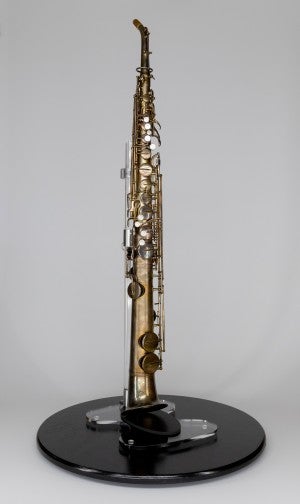
A Buescher straight alto saxophone made in 1926. Photo by E. Ganter for ARTICA - The Archives of Interlochen Center for the Arts.
“Imagine that you’re struggling to get your sound just right on your instrument,” Goldwasser explains. “You’re trying everything: a new mouthpiece or a new reed. But the last thing you would think to do is to pick up a completely different horn. This collection allows you to not only try new instruments, but to be inspired by the history and lineage of the music you’re making today.”
“For example, the straight alto saxophone has been played by many guest artists and teachers over the years,” Goldwasser continues. “When I drop the names for students, they say, ‘Whoa, they played this horn?’ And I can say, ‘Yes, and now you have, too.’”
Goldwasser and Nelson are also making the collection available to Arts Academy students interested in conducting research and artistic projects. In addition to the two creative writing students who are creating the collection’s website, Nelson, Goldwasser, and Ganter are overseeing independent projects by students in the Music, Film & New Media, and Visual Arts divisions.
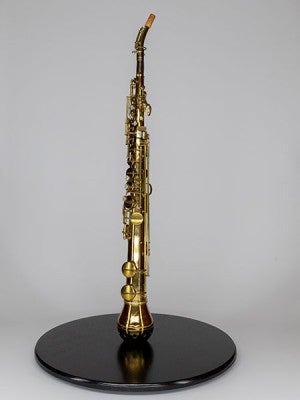
A prototype of the Conn-O-Sax, an updated version of the heckelphone made by C.G. Conn. Photo by E. Ganter for ARTICA - The Archives of Interlochen Center for the Arts.
“When [Goldwasser] did a master class for Arts Academy students last spring, saxophonist Gabe Proctor (IAA 21-) was inspired to do a specialized independent study,” Nelson says. “He’ll be working with [Goldwasser] remotely to conduct a yearlong project on the Conn-O-Sax.”
“We also have visual arts students who are interested in sketching instruments from the collection as part of their senior project, as well as some film & new media students who are working on video and even animation projects,” Nelson says.
Nelson also hopes the collection’s selection of world music instruments can be utilized as an educational tool.
“It’s an untapped resource that could be used to create curriculum in history, global studies, and diversity, equity, and inclusion,” she says.
Creating a vision for the future
One of Goldwasser’s most important goals, however, is providing recommendations for the future of the Greenleaf Collection.
“I envision this collection being an open database of information,” Goldwasser says. “I see it as an open call for students, teachers, and guest artists to get a moment of their passion’s history. My hope is that within the next two years, the Greenleaf Collection will be a very quick, one-stop shop for your questions about Conn, Elkhart, and more.”
One of the collection’s most pressing needs is for a new space on Interlochen’s campus, a place where the collection will be safe, secure, and most importantly, seen—by not just a handful of students by appointment, but by hundreds of visitors on a daily, walk-in basis.
“The space that we currently have is not a display space—it’s really just a storage space,” Nelson says. “Because we don’t have a dedicated display space, many of the ‘crown jewels’ of the Greenleaf Collection have been loaned to other museums in the United States. We are trying to unite the Greenleaf Collection in a place where people can enjoy it.”
Goldwasser and Nelson are also making plans to provide a continuity of curation of the Greenleaf Collection.
“Now that I’ve been given the opportunity to stand in temporarily as curator, I feel it’s even more important to keep this momentum going past this summer,” Goldwasser says. “I want to build the foundations so that if another specialist comes in next year, the process is already in place.”
“We are interested in all available options for the collection’s curation,” Nelson says. “We can dream big—which we have—but can also continue the model we used this summer, bringing in specialists for different instruments to provide the level of curation that Jake has provided for the saxophones.”
Living the dream
As the summer draws to a close, Goldwasser reflects on the transformational experience of curating, researching, and sharing the Greenleaf Collection.
“It’s a dream come true,” Goldwasser says. “This project is the first of its kind for me. It’s an honor to be a part of traditions and lineage, especially the traditions and lineage of a place like Interlochen.”
“This place has been the home and the haven for musicians to teach their craft at the highest level offered. When I think about the footsteps I’m following, it’s more than inspiring—as an educator and as a performer.”
And despite spending six weeks immersed in the collection, Goldwasser still feels a sense of awe when he walks in the door.
“I’m a kid in a candy store,” he says. “It’s a very special opportunity. I’ve loved every minute of it.”
